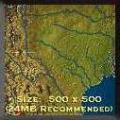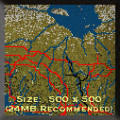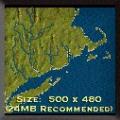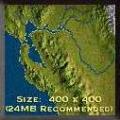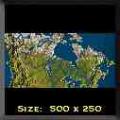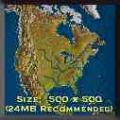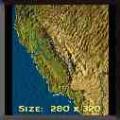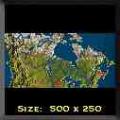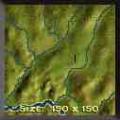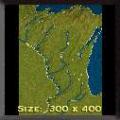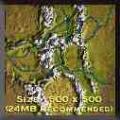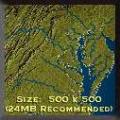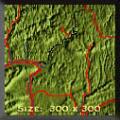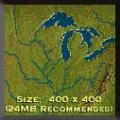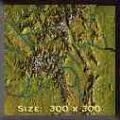North America
Maps based in North America.
115 files
-
Author's Comments: I tried to be as real as I could in creating this... and for the most part I think I succeeded. Keep in mind this was my first map and I changed a few things to make gameplay more practical. There are no events or goals in this map. It has been designed for those of you, like myself, who just love to lay track and have fun!
By Guest146 0 -
Goal: 1900 brought change to the Texas region, along with new challenges.
By Guest213 0 -
Goal: In 1900, the area between Lake Nipissing and James Bay was largely uninhabited and unexploited. Then in 1902, the Temiskaming & Northern Ontario Rly was built to link the Lake Temiskaming area with North Bay.
Though it struggled for the first few decades, the T&NO continued to build north and eventually reached the Arctic tidewater at Moosonee in 1932.
As it blasted its route through the Canadian Shield, the railway uncovered vast deposits of copper, nickel, iron, cobalt, and precious metals. It also made it possible to exploit the vast timber resources of the area.
Renamed to the Ontario Northland Railway in 1946, the line evolved into a profitable and modern transportation system.
Can you take on the Ontario Northland in its early years, make it profitable, and help develop Ontario's Northern frontier?
By Guest140 0 -
Author's Comments: The Northeastern part of the United States is a very dense populated area from New York to Boston. The railroad came early to this area (1841 between Boston and Providence), and soon after a huge network was built, especially in Massa-chusetts. Railroad history tells about famous trains as Yankee Clipper, Merchants Limited and The Colonial. I suggest the player to start with a railroad from Boston to Providence. After a few years to consolidate your company, you can start building the trunk line to New York. In 1890 or so, the whole system should be built, and by this time it will take approximately 150 trains to run it. Note: From 1950 no steam locomotives are available.
By Guest162 0 -
Goal: San Francisco here I come! ...And so is the great earthquake of 1906. When it does, watch out. Then get the California-Western Railroad back on solid ground and go for the gold -- California Gold.
Author's Comments: Here's my latest map - San Francisco Bay. It includes all of the San Francisco Bay Area and a large part of Northern California from Monterrey to Santa Rosa and from the ocean to the Sierra Nevada Mountains. The San Joaquin Valley is also included. The map is fairly accurate, although I've taken some liberties with adding and iron ore and coal fields in the foothills and mountains. I've added some interesting events that, I hope, will make playing this map a little more fun and interesting. Helpful comments would be welcomed.
By Guest163 0 -
Goal: Great state of Wyoming, "The Equality State." Became US territory in 1868. Statehood on July 10, 1890. Current Population 453,588. Capital: Cheyenne. Size 96,988 sq. miles. 44th State.
Author's Comments: Wyoming, known for its cowboys and natural beauty, is a rough and tumble state. So, too is this map. Carefully created using USGS satellite maps and the latest national census (1990), the map is surprising accurate. All major cities, towns, villages and hamlets boasting over 300 in population have been accounted for. Even some surprises like Muddy Gap, population 28, find their way on to this map.
Wyoming industry is cattle, oil and more cattle. Uranium will become a vital industry at the start of the Cold War and continue into the present. Also, don't forget the coal rich mines of the state's Northeast corner. As for scenic beauty, nothing can beat the Teton Range and Yellowstone National Park.
Note: Keep on good terms with the Native Americans. Getting rights to the reservations are key to successfully linking the east and west.
Each player starts with a generous $500, 000. But watch out! With terrain like Wyoming's, you are going to need every penny during start-up.
Remember, this is a beta and I look forward to all you comments and questions. Accuracy is my pride, here, so please note any irregularities or inaccuracies to me.
By Guest164 0 -
Goal: The Western provinces are threatening succession and Quebec is leaning towards independence. What the country needs is something to connect them as a nation. That's where you come in...
Author's Comments: This is the Canada map from the original campaign ("Crossing the Divide", campaign pt. 6, #06cro~1.map), saved as a stand-alone scenario. Minor fixes.
By Guest167 0 -
Goal: The 1800s in North America. The cities are mostly small. Yet growing. The resources are abundant.
Author's Comments: Beat three other companies - the one with the highest Company Book value wins.
Get a Company Book Value of $100,000,000 to win the gold. If not, Silver - $60 million. Bronze - $20 million.
By Guest239 0 -
Goal: The Golden State beckons you. Come to its golden shores and make your fortune.
Author's Comments: The Golden State welcomes your railroad.
See if you can win the golden medal.
Beware though there is an earthquake event that can destroy trains, tracks and stations.
Also the historic 1905 flood that created the Salton Sea may also happen.
The actual ground scale is about 3 miles per cell. (not the 10 as in RRT2)
To relate on a smaller scale things like track building, maintenance are decreased by 50%.
By Guest138 0 -
Goal: So much for the national dream... The CPR failed in its goal to unite Canada. The country will likely disintegrate unless you can pull it back together.
Author's Comments: The premise is that the Canadian Pacific Railway never succeeded in building the transcontinental link. The human player begins in the west, but faces competition from railroads in both eastern Canada and the central United States.
I've tried to inject a sense of history into this scenario. Look for Gold Rushes, the Prairie Wheat Boom, and World War One as significant events.
By Guest212 0 -
Goal: A small town in Ohio has pinned its hopes on the railroad -- and you. Are you up to the challenge?
By Guest159 0 -
Goal: I used the heartland map. Added cities and ports and other changes; but used the same simple single player win events.
Operate a mainline Railroad between big port cities. Program the routes of shortline Railroads to feed cargo to your big cities. Possibility of 12 to 15 AI railroads for you to try to control. The GG1 and 1020 electric locos start up early for the mainline RR. A builders map with lots of micro-management and drop shipping.
By Gwizz164 0 -
Goal: Steamboats from St. Louis to Fort Benton have supplied the Montana Territory. Now it's time for Railroads to take over.
By Guest122 0 -
Goal: North to Alaska. Come to the far north and make your fortune. Or, take it from others.
Author's Comments: The Alaska map is very difficult. The starting investment money is double that of most scenarios. In single player try either Anchorage or Juneau.
By Guest160 0 -
Goal: The upper Midwest is rich in resources just waiting for the transportation revolution -- railroads!
Author's Comments: You may find revenue rather thin at first if you carry nothing but passengers and mail. Success in this scenario depends more on carrying freight than passengers--there weren't many big cities here, especially at the start, but resources were abundant. The potential for huge industrial expansion was there, it just needed the transportation infrastructure, mainly railroads, to make it happen.
I found the easiest place to start was to run a line from Milwaukee to either the Racine-Kenosha area or one at Lake Geneva. An aggressive but feasible start is Milwaukee-Madison. I began my expansion by going after whatever freight was available in the immediate area, followed by expansion across the region. It isn't difficult to start in several other areas of the map, but if you have more than one computer opponent there's a very good chance he will start in the Milwaukee area if you don't. That's not fatal but it will make things more of a challenge because you'll have to work around him to get access to the area later (or buy him out).
By Guest133 0 -
Goal: Colorado's mining industry will pay high prices to any rail company able to ship their goods.
Author's Comments: The first rails were rolled into Colorado in late June 1867 by the Union Pacific. These first connections were an attempt to link Denver with the east. It wasn't until 1887 that the formidable rockies were penetrated in Colorado with a difficult grade laid by the Colorado Central railroad from Denver to Georgetown through Clear Creek Canyon to tap the silver mines there. Some of the highest rails in the country were laid from Georgetown through Silver Plume up to Waldorf near Mt. McClellan to service the Vidler mine. Here, the Argentine Central used Shays to climb to 13,110 feet to give the tourists a view of Grays and Torreys peaks. In the summer you can still ride the narrow gauge from Georgetown to Silver Plume.
There are two traditional routes through the Colorado rockies from Denver to Grand Junction. But dozens of passes over the divide have seen rails over the years. Most were short haul, short lived, financial disasters motivated by the rich mineral deposits here. The first Denver-Grand Junction connection went from Denver to Bailey to Como to Buena Vista through the continental divide via the Alpine Tunnel, then downhill through Gunnison, Montrose, Delta to Grand Junction. The other principal route is Denver to Granby via a tunnel under the Divide, then to Kremmling, Glenwood Springs and Grand Junction. This is the route that Amtrak uses today. In the map, I have provided two reasonable grades to replace the tunnels. One at Monarch Pass which is very near the Alpine tunnel, and a couple of switchbacks over the divide between Denver and Summit County to replace the tunnel that exists near Granby.
In this map, it will probably be necessary to haul minerals to keep your railroad afloat. Passenger revenues are low and towns are too far apart to make much money. Locate the mines and try to get their output to the smelters which were historically located in Leadville, Pueblo, and Denver. The cattle ranches in the Arkansas River valley between Salida and Leadville were an important source of food for the miners and early rail stations. And there was and is a significant agriculture industry in the southeast part of the state. Another good source of revenue will be anything related to construction like gravel, cement, lumber, and logs. Prices for these building commodities often skyrocketed when demand was high.
By Guest183 0 -
Author's Comments: This amazing railroad was conceived as a shortcut for exporting goods to the Orient from the central US. The original route started in Wichita, Kansas and ended at the seaports near Los Mochis. It took almost 90 years to build, 90 million dollars and there are almost 90 tunnels. The first trains ran the route in 1961. This is some of the most spectacular and difficult terrain in the rail world. The switchbacks are a poor substitute for the bridges and tunnels, but you will get the idea of how hard it was to lay this rail.
Today the route between Chihuahua and Los Mochis still operates for passenger service. Your task in this scenario is to complete this 400 mile route and run 12 or more loads of any cargo or passengers over it. You have 30 years to do it for Gold, 50 for Silver, and 80 for Bronze. Also, you need a company book value of 20 million or more for the Gold.
By Guest146 0 -
Goal: The Chesapeake region is a diverse area with good industry and agriculture. Lead the B & O and be the king of the rails where it began in America.
Author's Comments: Command the B & O railroad in its earliest days.
By Guest218 0 -
Goal: From 1884 to 1938 the Williamsport and North Branch RR served the Susquehanna Valley. When the Coal and Lumber died, so did the W&NB. Can you out last the real railroad.
Author's Comments: This map is based on the Pennsylvania regions north and east of Williamsport, Pa. and should be used with RT2 Gold.
By Guest151 0 -
Goal: The heartland of the US is open for business. The future of auto manufacturing is a decision away. It will require the cooperation of all parties to succeed in this venture. For multi or single player.
Author's Comments: This is the PopTop RT2-TSC "Heartland, USA" map altered to provide novel single-player and multi-player win conditions. All other features of the scenario are unchanged.
Single-player: You have 25 years to meet an auto delivery schedule and attain minimum Company Book Value, Industry Investment and Industry Profit for up to 3 companies simultaneously. Bronze will be slightly harder than the regular Heartland bronze. After that, they diverge.
Multi-player: For stand-alone play or team competition. Players must work together as a team to make minimum lifetime unscheduled deliveries of autos and food by each company, where different companies have responsibility for delivering certain basic resources. You impose your own time limit as suggested in the larger attached text file.
By Guest157 0 -
Goal: The goal of this map is to simply out earn all of your competitors inside 30 years. You must have a company book value and a personal wealth that is higher than all others.
Your competitors already have their railroads in place. You should hurry. They will out build you if you let them.
Author's Comments: This map uses the same basic area as the B&S but doesn't go as far into New York and without any full scale class 1 RR's on the map. It's another topdog style scenario. You have to have the top Company Book Value and Personal Net Worth in 30 years to win the Gold. Anything else looses. This map was a quickie map to reuse the time frame and geographic area of the B&S map. I really wanted to run trains there!
By Guest117 0 -
Goal: Welcome to Georgia! The Civil War is over; reconstruction has begun. The rail lines have been destroyed, so it's up to you to rebuild.
Author's Comments: This is a moderate-sized map, original image from NOAA. It covers Georgia and parts of surrounding states.
It must begin in 1865; one AI opponent is required, two are the maximum.
The N.A. managers are allowed. Most industry is allowed, except coffee farms and nuclear power plants.
There are no general restrictions, except that you must lay track connected to your existing track.
The bronze requires $30MM company book value by 1905.
Silver is a $30MM player net worth by 1905.
Gold is having both.
I've put in all of the notable towns in Georgia on the map, but have not verified that they did exist in 1865. Of particular interest to me was putting in the lakes and rivers; Georgia-Florida-Alabama are currently in a "water war", so seeing where those rivers are was a good lesson for me.
Two of my grandparents worked for Georgia railroads, by the way.
By Guest138 0 -
Author's Comments: Blank Map. A map I started but never did anything with.
By Guest138 0 -
Goal: Reconstruction is ending, the Mississippi River is a barrier to the development of Louisiana.
Author's Comments: This is a map of the Louisiana/Mississippi area of the U.S. Set between 1860 to 1945 this map requires lots of bridges and careful planning to link resources with industries. Rates about medium difficulty.
By Guest154 0 -
Goal: Colorado's Rockies are rich with silver and gold. Come stake your claim.
Author's Comments: Single player mode only. There is not enough normal cargo for both you and the AIs. But there are unique and lucrative ways to earn your fortune.
Watch out if you try the 'stop your trains trick' to crash company stock prices. High negative company cash and low revenue and not hauling loads will in some cases have the right-of-ways in Denver taken from you.
By Guest154 0

